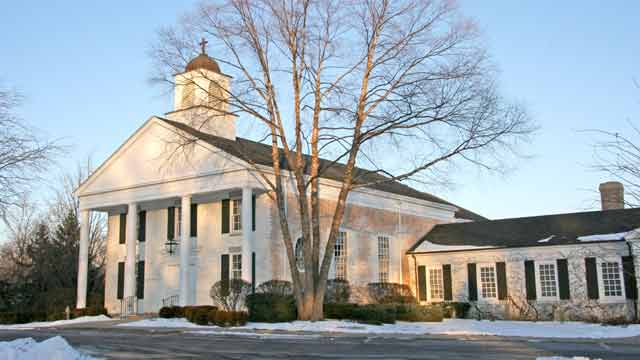Organized religion played a major role in the settling of Illinois and continues to influence the culture of our region. We enjoy highlighting places of worship, one in the country and one in the city, in each issue.
“Faith is to believe what you do not see; the reward of this faith is to see what you believe.”
–St. Augustine
Country Church
St. Mark’s Episcopal Church • Est. 1954
337 Ridge Road, Barrington Hills, (847) 381-0596, st-markschurch.org

This church was formed to provide an alternative to the “high” worship style of St. Michael’s in the Village of Barrington. Initially recognized by the diocese as a rural mission church, its 32 original members began meeting in each other’s homes in the spring of 1954.
By the following spring, the congregation had grown to the extent that a larger meeting space was needed, and the property on Ridge Road was purchased. At the time, it was part of Fox River Grove, since Barrington Hills wasn’t yet incorporated.
The first church, built with expansion in mind, was dedicated in 1956. By 1959, with membership doubled, St. Mark’s became an official parish; in 1962, Christmas Eve services were held in a barn across the road, to accommodate more than 400 people who attended.
A new building was begun in September 1963, and saw its first service that Christmas Eve. To reflect the congregation’s preference for simple worship, the building is a New England Colonial style, with seating for 300, including the balcony.
A day school was started in 1966, and an education wing was added in 1968. Today, St. Mark’s has programs for children ages 3 to 5.
The church has a music director and choir. With an average attendance of 124, Sunday morning services are held at 8 and 10:15, led by The Rev. David Gibbons.
City Church
Immanuel United Church of Christ • Est. 1852
1500 Old Church Road, Streamwood, (630) 830-2368, streamwoodiucc.org

Originally founded as Deutsche Vereinigte, Evangelische Lutherische Immanuel’s Gereinde by 13 local farmers in 1852, this church was built the following year, on five acres of land donated by W.G. Hubbard. It included a German school, parsonage, worship space and cemetery, which still adjoins the church.
The first wedding in the new building took place in April 1853. The church grew, and in 1868, the present frame church was dedicated. In 1879, a new school was built, and the original building was remodeled and used solely as the parsonage.
Its first instrument, a reed organ, was replaced in 1888 by an impressive pipe organ. Believed to be built by Emil Witzmann of the Chicago area, its manual compass is 58 notes and its pedal compass is 27 notes. It received the Historic Organ Citation from the Organ Historical Society in 1988.
The sanctuary interior features an elevated pulpit above the altar platform.
The church celebrated its Diamond Jubilee with three services in 1927, and the walls and ceilings were covered in the vintage tinwork that remains there today. “Ehre Sei Gott in der Höhe” – “Glory to God in the Highest” – is inscribed above the altar in gold letters.
The congregation joined the Evangelical and Reformed Church, and later, the United Church of Christ. A tornado in 1933 destroyed the center steeple, which was replaced with a smaller bell tower.
In 1926, congregants voted to hold a service in English on the first of each month; in 1959, they voted to have German services only on Good Friday. It was also in this year that the name was changed to Immanuel United Church of Christ.
Today’s congregation is led by interim Pastor Tom Glough. Services are Sunday mornings at 9 a.m., with music from the Tapestry and Bell choirs, and at 10:45, for a less formal meeting. ❚




















































